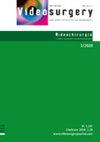分析社交媒体上钬激光前列腺摘除(HoLEP)视频的质量和有效性
IF 1.6
4区 医学
Q2 SURGERY
引用次数: 1
摘要
社交媒体用户的数量正在逐渐增加,他们花时间为自己收集很多有用的信息。在这里,我们分析了YouTube上钬激光前列腺摘除手术视频的质量。目的利用有效的问卷调查和评分系统评估YouTube上观看次数最多的HoLEP视频的质量,以评估其重要特征。材料和方法通过在YouTube上搜索“Holep”关键字,将观看次数最多的98个视频纳入本研究。3名接受过HoLEP培训的外科医生进行HoLEP评分系统评分(HSSS)后,采用美国医学协会基准评分(JAMAS)和全球质量评分(GQS)对视频进行分析,评估视频的技术质量。结果以外科技术视频(76.5%)和泌尿科医师上传视频(63.3%)为主。JAMAS、GQS和HSSS的中位数分别为1(0-3)、2(0-4)和1.5(0-11)。学术中心上传视频的平均GQS和JAMAS高于商业中心和泌尿科上传视频(p = 0.01;P = 0.01)。在最近5年上传的视频中,平均HSSS较低,而JAMAS较高(p = 0.03, p = 0.005)。点赞数越高的视频,GQS和HSSS的平均值越高(p = 0.01;P = 0.02)。结论YouTube上的HoLEP视频不足以获得有关手术的适当信息。近年来,学术中心上传的视频为患者和泌尿科医生提供了更有效的信息。为了增加信息的价值,需要检查在线材料,以便患者访问准确、可靠和适当的医疗保健信息。本文章由计算机程序翻译,如有差异,请以英文原文为准。
Analyzing the quality and validity of holmium laser enucleation of prostate (HoLEP) videos on social media
Introduction The number of social media users is gradually increasing, and they are spending their time gathering a lot of useful information for themselves. Here, we analysed the quality of Holmium Laser Enucleation of Prostate (HoLEP) surgery videos on YouTube. Aim To assess the quality of the most viewed HoLEP videos on YouTube using validated questionnaires and scoring systems developed to evaluate the significant features. Material and methods The most viewed 98 videos were included in this study by the search for ‘Holep’ keyword on YouTube. The Journal of American Medical Association Benchmark Score (JAMAS) and Global Quality Score (GQS) were used to analyse the videos after the validated HoLEP Scoring System Score (HSSS) was performed by 3 HoLEP trained surgeons to evaluate the technical quality of videos. Results The videos including surgical technique (76.5%) and uploaded by urologists (63.3%) constituted the majority of videos. The median of JAMAS, GQS, and HSSS were 1 (0–3), 2 (0–4), and 1.5 (0–11), respectively. The mean GQS and JAMAS of videos uploaded by academic centres was higher than those uploaded by commercial centres and urologists (p = 0.01; p = 0.01, respectively). The mean HSSS was lower in the videos uploaded in the last 5 years, while JAMAS was higher (p = 0.03, p = 0.005, respectively). The mean GQS and HSSS of videos with higher likes were found statistically significantly higher (p = 0.01; p = 0.02, respectively). Conclusions HoLEP videos on YouTube are not adequate to obtain proper information about the surgery. Videos uploaded by academic centres and in recent years provide more valid information for patients and urologists. To increase the value of information, online materials need to be checked, for patients to access accurate, reliable, and appropriate healthcare information.
求助全文
通过发布文献求助,成功后即可免费获取论文全文。
去求助
来源期刊
CiteScore
2.80
自引率
23.50%
发文量
48
审稿时长
12 weeks
期刊介绍:
Videosurgery and other miniinvasive techniques serves as a forum for exchange of multidisciplinary experiences in fields such as: surgery, gynaecology, urology, gastroenterology, neurosurgery, ENT surgery, cardiac surgery, anaesthesiology and radiology, as well as other branches of medicine dealing with miniinvasive techniques.

 求助内容:
求助内容: 应助结果提醒方式:
应助结果提醒方式:


